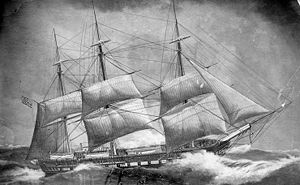USS Congress (1841)

USS Congress (1841)
|
|
| History | |
|---|---|
| Name: | USS Congress |
| Launched: | August 16, 1841 at Portsmouth Naval Shipyard |
| Commissioned: | May 7, 1842 |
| Struck: | 1862 (est.) |
| Fate: |
|
| General characteristics | |
| Type: | Frigate |
| Tonnage: | 1867 |
| Length: | 179 ft (55 m) (p.p.) |
| Beam: | 47 ft 9.6 in (14.569 m) |
| Draft: | 22 ft 6 in (6.86 m) |
| Propulsion: | Sails |
| Complement: | 480 officers and enlisted |
| Armament: | 4 × 8 in (200 mm) guns, 48 × 32 pdr (15 kg) guns |
USS Congress (1841) — the fourth United States Navy ship to carry that name — was a sailing frigate, like her predecessor, USS Congress (1799).
Congress served with distinction in the Mediterranean, South Atlantic Ocean, and in the Pacific Ocean. She continued to operate as an American warship until the American Civil War, where she was sunk by the ironclad CSS Virginia in battle off Newport News, Virginia.
Congress was launched at the Portsmouth Navy Yard on August 16, 1841 and placed in commission under Captain Philip Voorhees on May 7, 1842. Her first cruise — starting on July 15 — took her to the Mediterranean for service with the Squadron of Commodores Charles W. Morgan and Charles Morris.
In December 1843, Voorhees joined Commodore Daniel Turner's Brazil Squadron blockading Montevideo in safeguarding U.S. trade during the Uruguayan Civil War. Generally, the U.S. Navy stayed aloof from lower-South American troubles.
However, on September 29, 1844, Voorhees captured an armed Argentine schooner that delivered a mail to the Argentine commanding officer. This overreaction damaged the US-Argentina relation and resulted in a court martial for Vorhees. His impetuosity resulted in a few months suspension, for Voorhees, but did little damage to his career.
Congress remained active in the theatre until January 1845. She was then placed in ordinary at Norfolk, Virginia in March.
...
Wikipedia
